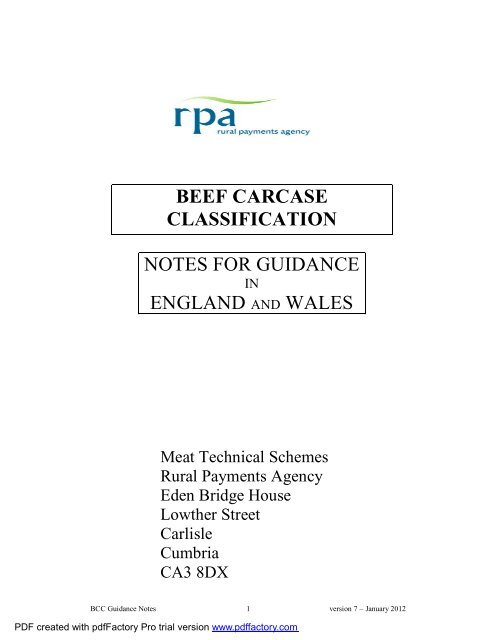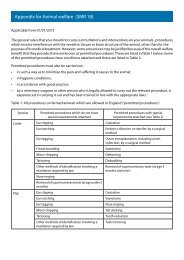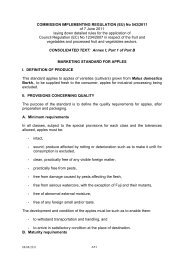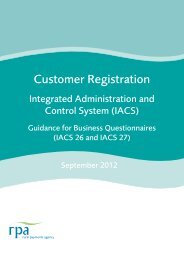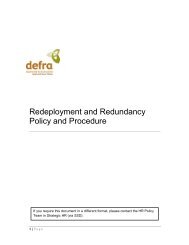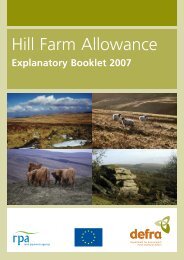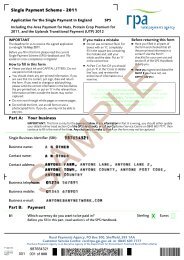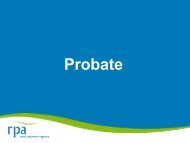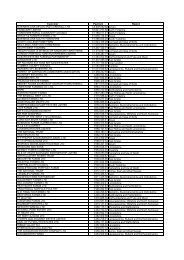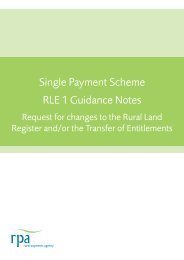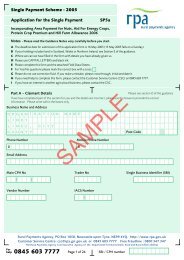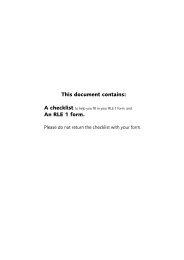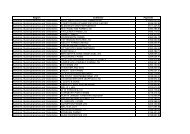BCC Notes for guidance Ver 7.pdf - The Rural Payments Agency ...
BCC Notes for guidance Ver 7.pdf - The Rural Payments Agency ...
BCC Notes for guidance Ver 7.pdf - The Rural Payments Agency ...
You also want an ePaper? Increase the reach of your titles
YUMPU automatically turns print PDFs into web optimized ePapers that Google loves.
BEEF CARCASE<br />
CLASSIFICATION<br />
NOTES FOR GUIDANCE<br />
IN<br />
ENGLAND AND WALES<br />
Meat Technical Schemes<br />
<strong>Rural</strong> <strong>Payments</strong> <strong>Agency</strong><br />
Eden Bridge House<br />
Lowther Street<br />
Carlisle<br />
Cumbria<br />
CA3 8DX<br />
<strong>BCC</strong> Guidance <strong>Notes</strong> 1 version 7 – January 2012<br />
PDF created with pdfFactory Pro trial version www.pdffactory.com
EUROPEAN COMMUNITY SCHEME FOR THE<br />
CLASSIFICATION OF BEEF CARCASES<br />
CONTENT<br />
Section A – General In<strong>for</strong>mation<br />
1. What is the Beef Carcase Classification Scheme?<br />
2. Purpose of the scheme<br />
3. Purpose of these notes.<br />
4. Definition of an adult bovine animal.<br />
Section B – Registration Requirements under <strong>BCC</strong><br />
5. Registration – general requirements<br />
6. Exempt slaughterhouses<br />
7. Can centres slaughtering 75 adult bovine animals or less per week carry out classification<br />
under the <strong>BCC</strong> scheme?<br />
8. Who undertakes the classification of carcases?<br />
Section C – Dressing Specifications and Carcase Classification<br />
9. Dressing Specifications.<br />
10. Classification of carcases.<br />
11. Con<strong>for</strong>mation Classes.<br />
12. Fat Classes.<br />
13. Recording con<strong>for</strong>mation and fat classes.<br />
14. 15 point scale.<br />
15. Classification categories<br />
16. Recording categories relating to animals aged 12 months or less.<br />
17. Recording required in<strong>for</strong>mation via labelling or stamping the carcase<br />
18. Weights.<br />
Section D – Communication of Classification Results and Record<br />
Keeping<br />
19. Communication of Classification Results.<br />
20. Record keeping<br />
21. In<strong>for</strong>mation to be recorded <strong>for</strong> bovine carcases<br />
Section E – <strong>BCC</strong> Classifier Licences<br />
22. <strong>BCC</strong> Classifier licences<br />
23. Applying <strong>for</strong> a classification licence.<br />
24. Monitoring of classification carried out by Licenced Classifiers.<br />
25. Withdrawal of licences.<br />
<strong>BCC</strong> Guidance <strong>Notes</strong> 2<br />
version 7 – January 2012<br />
PDF created with pdfFactory Pro trial version www.pdffactory.com
Section F – Video Imaging Analysis (VIA)<br />
26. Classification by automated grading techniques (Video Imaging Analysis – VIA)<br />
Section G – Inspections, Offences and Penalties<br />
27. Inspections.<br />
28. Offences and Penalties.<br />
Section H – Further Guidance, Publications and Data Protection.<br />
29. Further Guidance<br />
30. Publications and Forms.<br />
31. Data Protection.<br />
Appendix 1 – Fixed Penalty Guidance.<br />
Appendix 2 – legislation.<br />
Appendix 3 – Definitions.<br />
<strong>BCC</strong> Guidance <strong>Notes</strong> 3<br />
version 7 – January 2012<br />
PDF created with pdfFactory Pro trial version www.pdffactory.com
Section A – General In<strong>for</strong>mation<br />
What is the Beef Carcase Classification scheme?<br />
1. <strong>The</strong> Beef Carcase Classification scheme is a European Community (EC) wide<br />
scheme which requires EC approved slaughterhouses to classify adult beef<br />
carcases on the basis of a combination of their fat and con<strong>for</strong>mation.<br />
Purpose of the scheme<br />
2. <strong>The</strong> purpose of the scheme is to ensure the uni<strong>for</strong>m classification of adult beef<br />
carcases to guarantee producers fair payment based on the EC Community<br />
Grading scale <strong>for</strong> adult bovine animals delivered to slaughterhouses. This<br />
classification also improves the transparency of the market in carcases, to the<br />
benefit of all sectors of the industry.<br />
Purpose of these notes<br />
3. <strong>The</strong>se notes provide <strong>guidance</strong> to operators and staff of slaughterhouses on the<br />
classification of beef carcases. <strong>The</strong> notes set out the main provisions of the<br />
Community requirements and explain how they will apply in England &<br />
Wales. As separate legislative arrangements have been made in Scotland and<br />
Northern Ireland, slaughterhouses based there should contact their appropriate<br />
office <strong>for</strong> further <strong>guidance</strong>.<br />
3.1 You should also make yourself familiar with the Industry’s own Code of<br />
Practice.<br />
Definition of an adult bovine animal<br />
4. Under the Beef Carcase Classification Scheme the definition of an adult<br />
bovine carcase is a bovine animal with a live weight exceeding 300 kilograms.<br />
<strong>BCC</strong> Guidance <strong>Notes</strong> 4<br />
version 7 – January 2012<br />
PDF created with pdfFactory Pro trial version www.pdffactory.com
Section B – Registration Requirements under <strong>BCC</strong><br />
Registration - general<br />
5. Statutory Instruments, <strong>The</strong> Beef and Pig Carcase Classification (England)<br />
Regulations 2010 No. 1090 and <strong>The</strong> Beef and Pig Carcase Classification<br />
(Wales) Regulations 2011 No 1826 (W.198), require that an occupier of an<br />
EC approved slaughterhouse killing adult bovine animals must notify this fact<br />
in writing to the relevant agriculture department. In England and Wales the<br />
relevant agriculture department is the <strong>Rural</strong> <strong>Payments</strong> <strong>Agency</strong> (RPA). <strong>The</strong><br />
details to be notified are set out in Regulation 5 of SI 1090 (England) and<br />
Regulation 5 of SI 1826 (Wales). <strong>The</strong> Regulations also explain what<br />
slaughterhouse occupiers are required to do if changes occur in the notified<br />
details or if they cease to occupy a slaughterhouse.<br />
5.1 To ensure that the required in<strong>for</strong>mation is provided an RPA ‘Registration<br />
Details’ <strong>for</strong>m should be completed and returned to this office. A copy of the<br />
<strong>for</strong>m can be obtained from the Meat Technical Schemes section at Carlisle<br />
RPA or downloaded from our web site at rpa.defra.gov.uk then following the<br />
links ‘Full list of RPA schemes, Livestock schemes, Beef Carcase<br />
Classification<br />
5.2 Where any changes occur the operator must notify the RPA of the particulars<br />
within 28 days of the change.<br />
5.3 Where an operator ceases to be the operator of an approved slaughterhouse<br />
they must notify the RPA of the cessation date and the person(s) succeeding as<br />
operators of the slaughterhouse where applicable. This notification should be<br />
supplied within 10 days of the cessation.<br />
Exempt slaughterhouses<br />
6. Slaughterhouses with an annual average throughput of not more than 75 adult<br />
bovine animals per week (calculated on a rolling yearly basis) do not have to<br />
classify. However, such slaughterhouses will still be required to:<br />
• Register the slaughterhouse;<br />
• Keep records;<br />
• Permit entry and provide assistance to authorised officers.<br />
<strong>BCC</strong> Guidance <strong>Notes</strong> 5<br />
version 7 – January 2012<br />
PDF created with pdfFactory Pro trial version www.pdffactory.com
Can centers slaughtering 75 adult bovine animals or less per week<br />
carry out classification under the <strong>BCC</strong> scheme?<br />
7. Following the implementation of Statutory Instruments ‘<strong>The</strong> Beef and Pig<br />
Carcase Classification (England) Regulations 2010 (1090 / 2010) and <strong>The</strong><br />
Beef and Pig Carcase Classification (Wales) Regulations 2011 No 1826<br />
(W.198), small scale operators in England and Wales may choose to register<br />
and classify adult bovine animals under the Beef Carcase Classification<br />
scheme. In instances where such an operator chooses to classify bovine<br />
carcases they will be required to meet the scheme requirements on all adult<br />
bovine carcases at their plant. Please note that a small scale operator is deemed<br />
to be an operator of an approved slaughterhouse at which not more than 75<br />
adult bovine animals per week, as an annual average, are slaughtered.<br />
Who undertakes the classification of carcases?<br />
8. A slaughterhouse may use their own employees who have obtained a<br />
classification licence or another suitably qualified person / company who have<br />
the appropriate classification licence. (See Section E - <strong>BCC</strong> Classifier<br />
Licences).<br />
<strong>BCC</strong> Guidance <strong>Notes</strong> 6<br />
version 7 – January 2012<br />
PDF created with pdfFactory Pro trial version www.pdffactory.com
Section C – Dressing Specification and Carcase<br />
Classification<br />
Dressing Specifications<br />
9. In the UK a slaughterhouse which is registered under the Beef Carcase<br />
Classification scheme should ensure that adult bovine carcases are dressed<br />
inline with one of the three recognised dressing specifications;<br />
• Standard Specification,<br />
• EC Reference Specification,<br />
• UK Specification<br />
9.1 Details of the dressing specification trimming requirements are provided in<br />
our RPA booklet ‘Beef Carcase Classification Scheme, Guidance on dressing<br />
specifications and carcase dressing’.<br />
9.2 <strong>The</strong> dressing specification applied must be detailed on the appropriate records<br />
ascertaining to the carcase. Where a carcase has not been dressed inline with<br />
the dressing specification, records must be suitably annotated as Not Dressed<br />
to Specification (NDTS).<br />
Classification<br />
10. Carcases of adult bovine animals must be classified by assessment of<br />
con<strong>for</strong>mation and fat cover using the Community scale <strong>for</strong> the classification of<br />
adult bovine animals.<br />
<strong>BCC</strong> Guidance <strong>Notes</strong> 7<br />
version 7 – January 2012<br />
PDF created with pdfFactory Pro trial version www.pdffactory.com
Con<strong>for</strong>mation Classes<br />
11. Cattle con<strong>for</strong>mation is a visual assessment of the overall shape and flesh<br />
coverage of the carcases. <strong>The</strong> con<strong>for</strong>mation categories U, O and P can be<br />
further divided into upper (+) and lower (-) bands.<br />
Con<strong>for</strong>mation<br />
Class<br />
S<br />
Superior<br />
E<br />
Excellent<br />
U<br />
<strong>Ver</strong>y Good<br />
R<br />
Good<br />
Description<br />
All profiles extremely<br />
convex; exceptional<br />
muscle development<br />
(double muscled<br />
carcase type).<br />
All profiles convex to<br />
super-convex;<br />
exceptional muscle<br />
development.<br />
Profiles on the whole<br />
convex, very good<br />
muscle development.<br />
Profiles on the whole<br />
straight; good muscle<br />
development.<br />
Additional Provisions<br />
Round: very highly rounded<br />
double- muscled visibly<br />
separated seams.<br />
Back: very wide and very thick,<br />
up to the shoulder.<br />
Shoulder: very highly rounded.<br />
Round: very rounded.<br />
Back: wide and very thick, up<br />
to the shoulder.<br />
Shoulder: very rounded.<br />
Round: rounded.<br />
Back: wide and thick, up to the<br />
shoulder.<br />
Shoulder: rounded.<br />
Round: well-developed.<br />
Back: still thick but less wide at<br />
the shoulder.<br />
Topside spreads very<br />
markedly over the<br />
symphysis<br />
((symphisis) pelvis).<br />
Rump very rounded.<br />
Topside spreads<br />
markedly over the<br />
symphysis<br />
(symphisis).<br />
Rump very rounded.<br />
Topside spreads over<br />
the symphysis<br />
(symphisis).<br />
Rump rounded.<br />
Topside and rump<br />
are slightly rounded.<br />
O<br />
Fair<br />
Profiles straight to<br />
concave; average<br />
muscle development.<br />
Shoulder: fairly welldeveloped.<br />
Round: average development<br />
to lacking development.<br />
Back: average thickness to<br />
lacking thickness.<br />
Rump: straight<br />
profile.<br />
P<br />
Poor<br />
All profiles concave to<br />
very concave; poor<br />
muscle development.<br />
Shoulder: average<br />
development to almost flat.<br />
Round: poorly developed.<br />
Back: narrow with bones<br />
visible.<br />
Shoulder: flat with bones<br />
visible.<br />
<strong>BCC</strong> Guidance <strong>Notes</strong> 8<br />
version 7 – January 2012<br />
PDF created with pdfFactory Pro trial version www.pdffactory.com
Fat Classes<br />
12. <strong>The</strong> fat class is determined by a visual appraisal of external fat development.<br />
Fat assessment is in five classes ranging from 1 (very lean) to 5 (very fat) with<br />
classes 4 and 5 being subdivided into leaner (L) and fatter (H) bands.<br />
Class of fat cover Description Additional provisions<br />
1<br />
Low<br />
None up to low fat cover. No fat within the thoracic<br />
cavity<br />
2<br />
Slight<br />
Slight fat cover, flesh visible<br />
almost everywhere.<br />
Within the thoracic cavity the<br />
muscle is clearly visible<br />
3<br />
Average<br />
4<br />
High<br />
5<br />
<strong>Ver</strong>y High<br />
Flesh with the exception of the<br />
round and shoulder, almost<br />
everywhere covered with fat,<br />
slight deposits of fat in the<br />
thoracic cavity.<br />
Flesh covered with fat, but on<br />
the round and shoulder still<br />
partly visible, some distinctive<br />
fat deposits in the thoracic<br />
cavity.<br />
Entire carcase covered with fat;<br />
heavy deposits in the thoracic<br />
cavity.<br />
between the ribs.<br />
Within the thoracic cavity the<br />
muscle is still visible<br />
between the ribs.<br />
<strong>The</strong> seams of fat on the round<br />
are prominent.<br />
Within the thoracic cavity the<br />
muscle between the ribs may<br />
be infiltrated with fat.<br />
<strong>The</strong> round is almost<br />
completely covered with fat,<br />
so that the seams of fat are no<br />
longer clearly visible.<br />
Within the thoracic cavity the<br />
muscle between the ribs is<br />
infiltrated with fat.<br />
Recording con<strong>for</strong>mation and fat classes<br />
13. When describing a carcase in classification terms, the con<strong>for</strong>mation class must<br />
always be given be<strong>for</strong>e the fat class. For example, where a carcase is of<br />
con<strong>for</strong>mation class R and a fat class of 4L it would be recorded as R4L.<br />
15 point scale<br />
14. To further enhance the classification a slaughterhouse may adopt a ’15 point’<br />
scale in which each confirmation and fat class is subdivided into three i.e. low<br />
(-), medium (mid) and high (+) classes. Where the 15 point scale is used<br />
details of the sub classes must be included in the communication provided to<br />
the supplier of the animal <strong>for</strong> slaughter (see also paragraph 19<br />
‘Communication of Classification Results’)<br />
<strong>BCC</strong> Guidance <strong>Notes</strong> 9<br />
version 7 – January 2012<br />
PDF created with pdfFactory Pro trial version www.pdffactory.com
14.1. <strong>The</strong> classification, identification and weighing of the carcases must take<br />
place within 1 hour of slaughter. In cases where the automated grading<br />
techniques fail to classify carcases, classification and identification of these<br />
carcases shall take place on the day of slaughter.<br />
14.2. <strong>The</strong> Community Scale can be viewed via the leaflet ‘Community scale <strong>for</strong><br />
the classification of bovine carcases of adult bovine animals’ which is issued<br />
with the registration letter sent to centres. A copy may also be requested from<br />
the MTS section at the RPA office in Carlisle.<br />
Classification categories<br />
15. Under <strong>BCC</strong>, adult bovine carcases must be identified under one of the<br />
following categories:-<br />
• A – Carcases of uncastrated young male animals of less than 2 years of<br />
age.<br />
• B – Carcases of other uncastrated male animals.<br />
• C – Carcases of castrated male animals.<br />
• D – Carcases of female animals that have calved.<br />
• E – Carcases of other female animals.<br />
Recording categories relating to animals aged 12 months or less<br />
16. Under <strong>BCC</strong>, the definition of an adult bovine carcase is a bovine animal with a<br />
live weight exceeding 300 kilograms.<br />
16.1 Under Beef labeling regulations animals aged 12 months or less must be<br />
identified by one of the following;<br />
• Category V: bovine animals aged 8 months or less i.e. bovines<br />
from the day of birth until they reach the age of 8 months.<br />
• Category Z: bovine animals aged more than 8 months but not<br />
more than 12 months i.e. bovines from the day after reaching<br />
the age of 8 months until the day they reach the age of 12<br />
months.<br />
16.2 <strong>The</strong> current legislation governing the <strong>BCC</strong> and BLS schemes operate along<br />
side each other and there<strong>for</strong>e do not replace the requirements of each scheme<br />
legislation.<br />
16.3 Carcases exceeding a live weight of 300 kilograms fall under <strong>BCC</strong> and must<br />
be categorised as at paragraph 15. In instances where the carcase relates to an<br />
animal which also falls under the veal categories under BLS, the appropriate<br />
veal category must also be recorded.<br />
<strong>BCC</strong> Guidance <strong>Notes</strong> 10<br />
version 7 – January 2012<br />
PDF created with pdfFactory Pro trial version www.pdffactory.com
Recording required in<strong>for</strong>mation via labelling or stamping the carcase<br />
17. <strong>The</strong> classification and identification details (category, class of con<strong>for</strong>mation<br />
and fat cover) may be recorded by either stamping the carcases using an<br />
indelible and non toxic ink, the letters / numbers must be a minimum of 2cm<br />
in height, or by attaching labels. <strong>The</strong> marks must be applied or labels firmly<br />
attached on the hindquarters on the striploin at the level of the fourth lumbar<br />
vertebra and on the <strong>for</strong>equarters, on the brisket between 10 and 30 centimeters<br />
from the edge of the sternum. <strong>The</strong> marks / labels must not be removed be<strong>for</strong>e<br />
the quarters are boned.<br />
Where the classification is carried out by using automated grading techniques<br />
the use of labels is compulsory.<br />
17.1 <strong>The</strong> in<strong>for</strong>mation to be recorded is as follows:-<br />
If you intend to stamp the carcase you will need to show:<br />
a) <strong>The</strong> category of the animal;<br />
b) <strong>The</strong> class of con<strong>for</strong>mation and fatness.<br />
If you intend to use labels they must be tamper-proof, tear resistant and firmly<br />
attached to each quarter. <strong>The</strong> labels must be a minimum size of not less<br />
than 50cm². Labels must not be removed be<strong>for</strong>e the quarters are boned.<br />
Labels must show the following in<strong>for</strong>mation / indicators:<br />
a) <strong>The</strong> category of the animal;<br />
b) <strong>The</strong> class of con<strong>for</strong>mation and fatness.<br />
c) <strong>The</strong> approval number of the slaughterhouse;<br />
d) <strong>The</strong> identification/slaughter number of the animal;<br />
e) <strong>The</strong> date of slaughter;<br />
f) <strong>The</strong> weight of the carcase.<br />
g) And where applicable, that classification has been carried out by<br />
using automatic grading techniques.<br />
<strong>The</strong> indicators above must be legible and no alternations are permitted except<br />
if they are clearly marked on the label and carried out under the supervision<br />
of, and the practical conditions determined by the relevant licenced classifier<br />
(who has successfully obtained a <strong>BCC</strong> classifiers licence)<br />
<strong>BCC</strong> Guidance <strong>Notes</strong> 11<br />
version 7 – January 2012<br />
PDF created with pdfFactory Pro trial version www.pdffactory.com
17.2. Please be aware that in addition to the requirements of the Beef Carcase<br />
Classification scheme, there are also labelling requirements which apply under<br />
the Beef Labelling Scheme. All beef offered <strong>for</strong> sale in the EC falls under the<br />
Beef Labelling Scheme and must be labelled with certain compulsory<br />
in<strong>for</strong>mation. Guidance on the requirements of the scheme can be found in the<br />
Beef Labelling Guide, a copy of which can be obtained from the RPA or via our<br />
web site.<br />
Weights<br />
18. <strong>The</strong> Regulations require that adult bovine carcases must be weighed within 1<br />
hour from the time of slaughter.<br />
18.1. <strong>The</strong> recorded weight must be as per the actual scale display and must not be<br />
rounded.<br />
18.2.<strong>The</strong> accurate carcase weight must be recorded on labels and associated<br />
documentation<br />
18.3.the Regulations governing the scheme require that the weight of the carcases<br />
must be communicated back to the supplier of the animal <strong>for</strong> slaughter. Please<br />
refer to Section D ‘ Communication of Classifier Results and Record keeping’ .<br />
18.4.<strong>The</strong> inaccurate recording of carcase weights and the communication of<br />
inaccurate in<strong>for</strong>mation is deemed to be an offence under the Regulations and will<br />
fall under the en<strong>for</strong>cement provisions, see Section G, ‘Inspections, Offences and<br />
Penalties and the in<strong>for</strong>mation at Appendix 1’ .<br />
<strong>BCC</strong> Guidance <strong>Notes</strong> 12<br />
version 7 – January 2012<br />
PDF created with pdfFactory Pro trial version www.pdffactory.com
Section D – Communication of Classification Results<br />
and Record Keeping<br />
Communication of Classification Results<br />
19. <strong>The</strong> results of classification must be communicated in writing or by electronic<br />
means to whoever has the slaughtering carried out. This in<strong>for</strong>mation may be<br />
shown on an invoice or a document attached. In both instances the in<strong>for</strong>mation<br />
should be addressed to the supplier of the animal, or failing that to the physical<br />
or legal person responsible <strong>for</strong> the slaughter operations. <strong>The</strong> in<strong>for</strong>mation to be<br />
supplied is a follows:-<br />
• classification results,<br />
• category<br />
• the weight of the carcase, indicating whether it relates to warm or cold<br />
weight<br />
• the carcase presentation (dressing specification) applied at the moment<br />
of weighing and classification.<br />
• And where applicable, that classification has been carried out by using<br />
automatic grading techniques<br />
Although it is not a compulsory requirement it is beneficial to also provide the kill<br />
number of the animal and the date of slaughter.<br />
Centre which operate using the 15 point scale must include the subclasses in the<br />
communication. (See also paragraph 14 –‘15 Point Scale’).<br />
Record Keeping<br />
20. the regulations specify that records should be kept <strong>for</strong> a minimum of 12 months<br />
from the end of the calendar year to which the records relate.<br />
<strong>BCC</strong> Guidance <strong>Notes</strong> 13<br />
version 7 – January 2012<br />
PDF created with pdfFactory Pro trial version www.pdffactory.com
In<strong>for</strong>mation to be recorded <strong>for</strong> bovine carcases<br />
21. <strong>The</strong> following in<strong>for</strong>mation is required to be recorded :-<br />
- <strong>The</strong> result of the classification.<br />
- <strong>The</strong> approval number of the slaughterhouse.<br />
- <strong>The</strong> kill number of the animal from which the carcase was obtained.<br />
- <strong>The</strong> date of slaughter.<br />
- <strong>The</strong> weight of the carcase.<br />
- <strong>The</strong> dressing specification used.<br />
- A record that the prescribed communication has been effected.<br />
- <strong>The</strong> name, signature and classification licence number of the person<br />
who carried out the classification.<br />
21.1.During inspection visits our Inspecting Officers are required to check records<br />
relating to carcases to confirm that the required in<strong>for</strong>mation is being recorded.<br />
<strong>The</strong>re<strong>for</strong>e during visits our Inspecting Officers will request that records be<br />
provided.<br />
<strong>BCC</strong> Guidance <strong>Notes</strong> 14<br />
version 7 – January 2012<br />
PDF created with pdfFactory Pro trial version www.pdffactory.com
Section E – <strong>BCC</strong> Classifier Licences<br />
22. <strong>The</strong> Regulations (Commission Regulation 1249/2008) require that the<br />
classification of adult bovine carcases must be undertaken by a person who has<br />
received a licence.<br />
22.1.In England and Wales licences will be issued by the <strong>Rural</strong> <strong>Payments</strong> <strong>Agency</strong> to<br />
those applicants who have successfully undertaken a classification test. This test<br />
is to demonstrate that an applicant has the necessary technical skill to ensure that<br />
classification is carried out in line with the requirements.<br />
22.2.Slaughterhouses may carry out their own classification with suitably qualified<br />
staff or may employ the services of another suitably qualified person/ company.<br />
22.3.A Sample of the current <strong>BCC</strong> licence which is issued to qualified classifiers in<br />
England and Wales may be viewed via the RPA web site at rpa.defra.gov.uk<br />
following the links ‘Full List of RPA Schemes, Livestock Schemes, Beef<br />
Carcase Classification, Classification Licences’<br />
22.4.Unlicensed classification is an offence, the commission of which will render the<br />
slaughterhouse operator and the classifier liable to a fine or prosecution.<br />
Applying <strong>for</strong> a classification licence<br />
23. A licence application <strong>for</strong>m may be obtained from either the MTS Section at the<br />
Carlisle Office, from the Inspecting Officer at the time of an inspection or<br />
downloaded from the RPA web site.<br />
23.1.Each application <strong>for</strong> a licence should be submitted on <strong>for</strong>m ‘Application <strong>for</strong> a<br />
<strong>BCC</strong> Licence’ (MTSA1) enclosing 2 passport style photographs. One of the<br />
photographs must be certified on the reverse as ‘I certify that this is a true<br />
likeness of …. (name of applicant)….’ and countersigned by the manager<br />
signing the application <strong>for</strong>m.<br />
23.2. <strong>The</strong> completed <strong>for</strong>m and the required photographs should be <strong>for</strong>warded to the<br />
following address <strong>for</strong> processing:-<br />
• Meat Technical Schemes Manager<br />
<strong>Rural</strong> <strong>Payments</strong> <strong>Agency</strong><br />
Eden Bridge House<br />
Lowther Street<br />
Carlisle<br />
Cumbria, CA3 8DX<br />
Tel: 01228 640369<br />
<strong>BCC</strong> Guidance <strong>Notes</strong> 15<br />
version 7 – January 2012<br />
PDF created with pdfFactory Pro trial version www.pdffactory.com
23.3.On receipt of the request an RPA inspector will visit applicants to ensure that<br />
they understand the principles of classification and that they have the technical<br />
skills required to classify carcases in line with the classification requirements.<br />
This is conducted by the applicant undertaking a <strong>BCC</strong> Licence test which is set<br />
by the Livestock and Meat Inspectorate. Successful applicants will be issued<br />
with the appropriate <strong>BCC</strong> classification licence.<br />
Monitoring of classification carried out by Licenced Classifiers<br />
24. During inspection visits our Inspecting Officers may request sight of a<br />
classifier’s licence to ensure that the term and conditions of the licence are being<br />
fully complied with. In these instances the licence must be made available to our<br />
Inspecting Officer <strong>for</strong> checking.<br />
24.1. Licenced classifiers will be required to make themselves available on a regular<br />
basis to ensure that the classification standards required are being achieved and<br />
the necessary technical skills are maintained. Failure to do so may result in the<br />
licence being withdrawn.<br />
24.2. Where a person who has obtained a classifier licence is no longer required to<br />
carry out the classification of adult bovine animals the RPA must be notified and<br />
the licence returned <strong>for</strong> disposal.<br />
Withdrawal of a licence<br />
25. Your attention is drawn to the provisions in the regulations governing licences.<br />
You should note in particular that a licence will become invalid if the licensed<br />
classifier leaves the employment of the employer specified on his/her licence or<br />
(if self employed) his/her home address changes.<br />
25.1. A classifier’s licence may be revoked if an inspection shows that classification<br />
standards are not being met.<br />
25.2. Any invalid licences must be returned to Meat Technical Schemes, Carlisle<br />
RPA, <strong>for</strong> disposal.<br />
<strong>BCC</strong> Guidance <strong>Notes</strong> 16<br />
version 7 – January 2012<br />
PDF created with pdfFactory Pro trial version www.pdffactory.com
Section F – Video Imaging Analysis (VIA)<br />
Classification by automated grading techniques (Video<br />
Imaging Analysis - VIA)<br />
26. A visual image taken of the carcase is used by the machine program to determine<br />
the classification results of that carcase. <strong>The</strong> contours of a carcase are analysed<br />
to assess its con<strong>for</strong>mation based on the EUROP classification scale and the fat<br />
class is determined by comparing the amount of red (flesh) and white (fat)<br />
shown on the image.<br />
26.1. Automated grading technology, or VIA (Video Imaging Analysis) is approved<br />
<strong>for</strong> use across the UK and licences can be issued to slaughterhouses who have<br />
installed the appropriate technology.<br />
26.2. Classification by automated grading techniques will be valid only if the carcase<br />
presentation is identical to the presentation used during the certification test. <strong>The</strong><br />
certification test was conducted in 2010. Any request <strong>for</strong> amendments to the<br />
approved carcase presentation must be made in writing <strong>for</strong> consideration be<strong>for</strong>e<br />
being implemented.<br />
26.3. Establishments operating classification by using automated grading techniques<br />
must:-<br />
• be in possession of an appropriate licence.<br />
• Identify the category of the carcase (For this purpose the system <strong>for</strong> the<br />
identification and registration of bovine animals, referred to in Title I of EC<br />
Regulation 1760/2000 (Identification and registration of bovine animals),<br />
must be used ;)<br />
• Keep daily control reports on the functioning of the automated grading<br />
techniques, including in particular any shortcomings encountered and actions<br />
taken where necessary.<br />
26.4. Carcase labels, records and remittance advice, must record all necessary<br />
in<strong>for</strong>mation including the fact that classification has been carried out by using<br />
automatic grading techniques. Where classification is carried out by automated<br />
grading techniques the use of labels is compulsory.<br />
26.5. <strong>The</strong> classification, identification and weighing of the carcases must take place<br />
within 1 hour of slaughter. In cases where the automated grading techniques fail<br />
to classify carcases, classification and identification of these carcases shall take<br />
place on the day of slaughter.<br />
26.6. Any VIA machine will need to be maintained and serviced on a regular basis to<br />
ensure that everything continues to work properly. Each machine must be<br />
<strong>BCC</strong> Guidance <strong>Notes</strong> 17<br />
version 7 – January 2012<br />
PDF created with pdfFactory Pro trial version www.pdffactory.com
checked daily and a control report kept on the functioning of the automated<br />
grading techniques, including in particular any shortcomings encountered and<br />
actions taken where necessary. This must be available <strong>for</strong> inspection on request.<br />
26.7. A slaughterhouse using VIA must also have a licenced classifier , on site at all<br />
times to undertake grading if a machine stops working. (please refer to Section<br />
E, ‘<strong>BCC</strong> Classifier Licences’, <strong>for</strong> infromation on obataining a classifier licence).<br />
<strong>BCC</strong> Guidance <strong>Notes</strong> 18<br />
version 7 – January 2012<br />
PDF created with pdfFactory Pro trial version www.pdffactory.com
Section G – Inspections, Offences and Penalties<br />
Inspections<br />
27. Officers of the RPA Meat and Livestock Inspectorate <strong>for</strong> England and Wales will<br />
carry out checks on EC approved slaughterhouses, (which are not exempt), twice<br />
a quarter as a minimum. Additional follow-up visits will be carried out if<br />
failings are found. Please note that all inspection visits carried out under the Beef<br />
Carcase Classification scheme are made on an unannounced basis.<br />
27.1. Inspections at centres which choose to become registered under the scheme on a<br />
voluntary basis will also be visited on a regular basis.<br />
27.2. EC approved slaughterhouses which are exempt or claim exemption may also be<br />
visited from time to time. You are required to give inspecting officers all<br />
reasonable assistance and it is an offence to deny them entry to your premises.<br />
27.3. Operators are required to grant access to their premises at all reasonable times.<br />
Offences and Penalties<br />
28. Failure to comply with the requirements of the regulations may lead to financial<br />
penalties being issued or further legal proceedings being taken.<br />
28.1. A person is guilty of an offence under <strong>The</strong> Beef and Pig Carcase Classification<br />
(England) Regulations 2010 and <strong>The</strong> Beef and Pig Carcase Classification<br />
(Wales) Regulations 2011, if he / she;<br />
• Contravenes the requirements of <strong>The</strong> Beef and Pig Carcase<br />
Classification (England) Regulations 2010 and <strong>The</strong> Beef and Pig<br />
Carcase Classification (Wales) Regulations 2011.<br />
• Fails to obtain and comply with the requirements of the classifiers<br />
licence to carry out classification or the licence authorizing the use of<br />
the automated grading equipment <strong>for</strong> the classification of bovine<br />
carcases.<br />
• Fails to comply with the notification requirements.<br />
• Fails to keep the required records.<br />
• Obstructs a person acting under the regulation access to a premise or<br />
records without reasonable cause.<br />
• Contravenes or fails to comply with any En<strong>for</strong>cement Notice served.<br />
• Applies misleading marks or labels.<br />
All offences are punishable by a fine. Offences covered by ‘misleading marks or<br />
labels may lead to referral to a Crown Court where fines are unlimited.<br />
For further in<strong>for</strong>mation please refer to the <strong>guidance</strong> detailed at<br />
Appendix 1<br />
<strong>BCC</strong> Guidance <strong>Notes</strong> 19<br />
version 7 – January 2012<br />
PDF created with pdfFactory Pro trial version www.pdffactory.com
Section H – Further Guidance, Publications and Data<br />
protection.<br />
Further Guidance<br />
29. Additional <strong>guidance</strong> can be obtained via the RPA web site at rpa.defra.gov.uk<br />
under Full list of RPA Schemes, Livestock schemes, Beef Carcase Classification.<br />
Our Inspecting Officers will also be happy to provide <strong>guidance</strong> during their regular<br />
visits when requested or required.<br />
<strong>The</strong>se notes do not cover all the provisions of the relevant EC and UK legislation<br />
(details of which are set out in paragraphs 5 and 6 of these notes). <strong>The</strong>se notes<br />
should there<strong>for</strong>e be read in conjunction with the legislation and not as an<br />
alternative to it.<br />
Publications & Forms<br />
30. <strong>The</strong> following publications are also available <strong>for</strong> your use and can be requested<br />
from the Meat Technical Schemes at Carlisle RPA tel 01228 640369 or obtained<br />
via our web site;<br />
Booklets<br />
• Beef Carcase Classification Scheme – Guidance on dressing<br />
specifications and carcase classification.<br />
• Community scale <strong>for</strong> the classification of carcases of adult bovine<br />
animals.<br />
Forms<br />
• Beef carcase Classification Scheme, Registration Details.<br />
• Application <strong>for</strong> a <strong>BCC</strong> Licence (MTSA1)<br />
Data Protection Notice<br />
31. Defra is the data controller <strong>for</strong> any personal data that you give to the <strong>Rural</strong><br />
<strong>Payments</strong> <strong>Agency</strong>. Your personal in<strong>for</strong>mation will be protected in line with the<br />
Data Protection Act 1998. We will use the data mainly to support the application<br />
it relates to. We may also use it in line with the Data Protection Act, <strong>for</strong> other<br />
purposes as we explain in the scheme <strong>guidance</strong> and on the Access to In<strong>for</strong>mation<br />
pages on our website: http://www.rpa.defra.gov.uk/rpa/index.nsf/home then put<br />
‘Access to In<strong>for</strong>mation’ into the search box. If you have any questions on our<br />
Data Protection policy, please telephone our Customer Service Centre.<br />
<strong>BCC</strong> Guidance <strong>Notes</strong> 20<br />
version 7 – January 2012<br />
PDF created with pdfFactory Pro trial version www.pdffactory.com
Appendix 1<br />
Fixed Penalty Guidance<br />
Introduction<br />
1. <strong>The</strong> regulatory requirements are set out in the Beef and Pig Carcase<br />
Classification (England) Regulations 2010 (S.I. 2010/1090) and the Beef and<br />
Pig Carcase Classification (Wales) Regulations 2011 (S.I. 2011/1826). This<br />
<strong>guidance</strong> applies to en<strong>for</strong>cement activities under these Regulations, and is<br />
designed to be applied by the <strong>Rural</strong> <strong>Payments</strong> <strong>Agency</strong> (RPA). <strong>The</strong>se<br />
Regulations also cover the requirement <strong>for</strong> Dead Weight Price Reporting.<br />
<strong>The</strong>se Regulations en<strong>for</strong>ce Article 42 of, and Annex V to, Council Regulation<br />
(EC) No 1234/2007 and Commission Regulation (EC) No 1249/2008.<br />
En<strong>for</strong>cement at a glance<br />
2. Where there is evidence that an offence has been committed, the Secretary of<br />
State <strong>for</strong> England or the Deputy Minister of Agriculture <strong>for</strong> Wales, may issue<br />
an in<strong>for</strong>mal written warning, saying that an offence has been committed,<br />
advising what steps should be taken and warning of possible future action.<br />
3. In addition, the regulations provide <strong>for</strong> three kinds of <strong>for</strong>mal en<strong>for</strong>cement<br />
action:<br />
(a)<br />
(b)<br />
(c)<br />
en<strong>for</strong>cement notice;<br />
penalty notice; and<br />
criminal prosecution.<br />
4. An en<strong>for</strong>cement notice may be given if the Secretary of State <strong>for</strong> England or<br />
the Deputy Minister of Agriculture <strong>for</strong> Wales has reason to believe that an<br />
offence has been committed under the Regulations. An en<strong>for</strong>cement notice<br />
will specify what the offence is, and what action the recipient must do, or stop<br />
doing, within a period specified in the notice. Any person who contravenes or<br />
fails to comply with a notice is guilty of an offence. A person may either<br />
appeal to the Meat Technical Scheme (MTS) team at Carlisle RPA as soon as<br />
possible or they may appeal to a magistrates’ court within one month of being<br />
given the en<strong>for</strong>cement notice if they have reason to believe that the notice<br />
should not have been issued.<br />
5. A penalty notice may be given if the Secretary of State <strong>for</strong> England or the<br />
Deputy Minister of Agriculture <strong>for</strong> Wales has reason to believe that an offence<br />
has been committed under the Regulations. It may be used as an alternative to<br />
prosecution. A penalty notice may be <strong>for</strong> an amount up to a maximum of<br />
£5,000. Where a person is given a penalty notice they have 28 days from the<br />
date the notice was given to pay the fine. If the fine is paid within the 28 day<br />
period, they will avoid prosecution. Criminal proceedings cannot be brought<br />
<strong>BCC</strong> Guidance <strong>Notes</strong> 21<br />
version 7 – January 2012<br />
PDF created with pdfFactory Pro trial version www.pdffactory.com
against that person <strong>for</strong> the offence to which the notice relates be<strong>for</strong>e the end of<br />
the 28 day period. Failure to pay within this timeframe is not an offence, but<br />
may lead to criminal proceedings.<br />
6. Criminal proceedings may be brought <strong>for</strong> an offence under the Regulations,<br />
including failure to comply with an en<strong>for</strong>cement notice. <strong>The</strong>y may also be<br />
brought if a person fails to pay the penalty due under a penalty notice.<br />
Consideration of Offence<br />
7. Where there is reason to believe that an offence has been committed the<br />
inspector will consider what action is appropriate in the circumstances. This<br />
will depend on the nature of the offence, and any other relevant factors.<br />
8. <strong>The</strong> seriousness of the offence and scale of the breach (which is considered to<br />
be an indicator of likely monetary gain) will determine initially which level of<br />
en<strong>for</strong>cement action would be applicable, as set out in the table below. [NB the<br />
table only covers scale not seriousness of offence]<br />
Determining the appropriate en<strong>for</strong>cement action<br />
9. <strong>The</strong> en<strong>for</strong>cement table is to give <strong>guidance</strong> and visibility as to the level of<br />
offence, and the course of action RPA would consider taking in each instance<br />
where an offence is committed, and the resulting penalty amount.<br />
<strong>The</strong>re will be three basic levels of fixed penalty depending on the nature of the<br />
offence committed. <strong>The</strong>se are £1000, £2500 or £4500 as set out below in an<br />
en<strong>for</strong>cement table.<br />
Level 1<br />
1 st OFFENCE 2 nd OFFENCE 3 rd OFFENCE<br />
Warning Letter<br />
En<strong>for</strong>cement<br />
Notice<br />
Penalty Fine -<br />
£1000<br />
SUBSEQUENT<br />
OFFENCE<br />
Criminal<br />
Proceedings<br />
Level 2<br />
Warning Letter<br />
En<strong>for</strong>cement<br />
Notice<br />
Penalty Fine -<br />
£2500<br />
Criminal<br />
Proceedings<br />
Level 3<br />
En<strong>for</strong>cement<br />
Notice<br />
Penalty Fine –<br />
£4500<br />
Criminal<br />
Proceedings<br />
Criminal<br />
Proceedings<br />
10. Level 1 offences are low risk issues affecting less than 25% of carcases<br />
witnessed during an inspection visit.<br />
11. Level 2 offences are medium risk issues affecting between 25% and 50% of<br />
carcases witnessed during an inspection visit.<br />
<strong>BCC</strong> Guidance <strong>Notes</strong> 22<br />
version 7 – January 2012<br />
PDF created with pdfFactory Pro trial version www.pdffactory.com
12. Level 3 offences are high risk issues affecting more than 50% carcases<br />
witnessed, where offence relates to at least 20 beef carcases witnessed or 10<br />
pig carcases witnessed.<br />
<strong>The</strong>se levels are based on a minimum of 40 beef carcases or 20 pig carcases<br />
checked per visit.<br />
13. Offences relating to failure of notification by an operator, licences, and<br />
records and marks are also considered to be Level 3 offences (regulations 27<br />
to 29 of S.I. 2010 No. 1090 and S.I. No. 2011/1826 refer). An obstruction<br />
offence under regulation 30 of the S.I’s (<strong>for</strong> instance obstructing an inspector,<br />
failing to assist, giving false in<strong>for</strong>mation) will usually result directly in<br />
prosecution.<br />
14. Other factors may also be taken into account which may affect the decision on<br />
the appropriate en<strong>for</strong>cement action. Those factors include, but are not limited<br />
to:-<br />
• seriousness of offence;<br />
• duration of non compliance;<br />
• history of non compliance;<br />
• financial gain made by the person as a result of non-compliance;<br />
• previous action taken by the en<strong>for</strong>cement authority to help the person<br />
comply with the regulations;<br />
• compliance with advice given, and action taken to repair or reduce the<br />
non-compliance;<br />
• any co-operation or willingness given to the en<strong>for</strong>cement authority by<br />
the person responding to the non compliance; or<br />
• where the non compliance was committed by an employee of the person,<br />
the extent to which the employee was acting outside of their authority.<br />
15. <strong>The</strong> table (overleaf) is stepwise, with an operator moving up and down the<br />
penalty scale in accordance with their response and the action carried out to<br />
resolve the issues identified.<br />
Detailed Implementation<br />
16. Where an inspector carries out an inspection and believes that an offence has<br />
been committed they will in<strong>for</strong>m the operator at the time of the visit verbally<br />
and hand the operator a deficiency notice. A report will be made to the MTS<br />
team in RPA Carlisle.<br />
17. Where a Level 1 or 2 offence is identified an in<strong>for</strong>mal verbal warning will be<br />
issued by the inspector and a deficiency notice will be handed to the Food<br />
Business Operator. This will be recorded on the operator’s file <strong>for</strong> future<br />
reference and followed up with a written warning letter where appropriate.<br />
Should an inspector discover on a subsequent inspection that the same offence<br />
is occurring, or has not been fully resolved, an en<strong>for</strong>cement notice will be<br />
considered.<br />
<strong>BCC</strong> Guidance <strong>Notes</strong> 23<br />
version 7 – January 2012<br />
PDF created with pdfFactory Pro trial version www.pdffactory.com
An operator who has reason to believe the en<strong>for</strong>cement notice should not have<br />
been given can appeal by making a complaint to a magistrates’ court within<br />
one month of the date of the notice.<br />
An operator may also appeal in<strong>for</strong>mally to the MTS team at Carlisle RPA with<br />
reasons or further evidence as to why the en<strong>for</strong>cement notice should not have<br />
been issued.<br />
Non-compliance with an en<strong>for</strong>cement notice will usually lead to a penalty<br />
notice. Where an en<strong>for</strong>cement notice is issued and evidence is found on a<br />
follow-up inspection that the en<strong>for</strong>cement notice has not been complied with,<br />
the inspector will in<strong>for</strong>m the operator of the continuing offence. <strong>The</strong> inspector<br />
will submit his report to the MTS team in RPA Carlisle who will assess the<br />
findings and issue a penalty notice if deemed applicable.<br />
18. Where a Level 3 offence is identified, due to the seriousness of this category<br />
of offence, an en<strong>for</strong>cement notice will generally be issued in the first instance.<br />
19. Where a penalty notice is considered appropriate, the MTS team will weigh up<br />
all the factors relating to the case, and using the table at paragraph 9 as a<br />
guide, come to a recommendation as to the amount the penalty fine should be.<br />
<strong>The</strong> MTS team will scrutinise all penalty notice recommendations to ensure a<br />
reasonable degree of consistency in how these are being applied and will issue<br />
the notices to the operator centrally.<br />
20. Where a single inspection visit results in the discovery of more than one<br />
offence then the offences will be treated separately and given, if applicable,<br />
individual en<strong>for</strong>cement or penalty notices.<br />
21. We will aim to issue a written warning, en<strong>for</strong>cement notice or penalty notice<br />
within 14 days of completion of the inspection. We aim to complete<br />
inspection into potential offences within three months.<br />
Payment of penalties<br />
22. Payment of the penalty specified in a penalty notice within 28 days of issue<br />
discharges any liability to be convicted of that offence. <strong>The</strong> penalty notice<br />
will specify how payment should be made, and where it should be sent to.<br />
Payment in cash is not permitted.<br />
23. A penalty notice can be withdrawn be<strong>for</strong>e or after the payment of a penalty,<br />
where there is reason to believe that it should not have been given. Where a<br />
penalty notice is withdrawn, any monies paid will be repaid in full within 28<br />
days of withdrawal of the notice.<br />
Criminal Prosecution<br />
24. Where a penalty notice is issued and the penalty is not paid within 28 days of<br />
issue, this may lead to criminal prosecution.<br />
<strong>BCC</strong> Guidance <strong>Notes</strong> 24<br />
version 7 – January 2012<br />
PDF created with pdfFactory Pro trial version www.pdffactory.com
25. In certain circumstances, RPA may also <strong>for</strong>ward in<strong>for</strong>mation to Local<br />
Authority Trading Standards <strong>for</strong> further investigation <strong>for</strong> example into other<br />
potential offences and possible prosecution.<br />
Fixed Penalty Guidance Q & A<br />
Q: I’ve just received an en<strong>for</strong>cement notice. What does it mean?<br />
A: It means that an inspector has reason to believe that a person has committed an<br />
offence under the Beef and Pig Classification Regulations 2010 (in relation to<br />
England) and 2011 (in relation to Wales) (the “Regulations”) as applicable. <strong>The</strong><br />
en<strong>for</strong>cement notice will provide the details of the offence and specify what measures<br />
must be taken to comply with the regulations.<br />
Q: How long does the en<strong>for</strong>cement notice last <strong>for</strong>?<br />
A: <strong>The</strong> duration of the notice is determined by the terms specified in the notice. <strong>The</strong><br />
notice will specify the measures that need to be taken or what needs to stop occurring,<br />
and the period in which this must be done.<br />
Q: Is it possible to have more than one en<strong>for</strong>cement notice?<br />
A: Yes, an en<strong>for</strong>cement notice can be issued <strong>for</strong> each category of offence as listed in<br />
the Regulations.<br />
Q: Can I appeal against an en<strong>for</strong>cement notice?<br />
A: <strong>The</strong>re are two ways to appeal. You can contact the MTS team in RPA Carlisle by<br />
letter enclosing any evidence that was not available at the time of inspection. You can<br />
also apply to the magistrates court <strong>for</strong> an order revoking the Notice by way of a<br />
complaint. You must appeal within one month.<br />
Q: What happens if I don’t do what the en<strong>for</strong>cement notice requires?<br />
A: Failure to comply with an en<strong>for</strong>cement notice is an offence and you may be issued<br />
with a penalty notice or prosecuted.<br />
Q: I’ve just received a penalty notice. What does it mean?<br />
A: A penalty notice is issued if an inspector has reason to believe that a person has<br />
committed an offence under the Regulations. If you pay the penalty notice within 28<br />
days of the date it was given you will not be prosecuted <strong>for</strong> the offence. Failure to pay<br />
the penalty notice within 28 days of the date it was given may lead to prosecution <strong>for</strong><br />
the original offence.<br />
<strong>BCC</strong> Guidance <strong>Notes</strong> 25<br />
version 7 – January 2012<br />
PDF created with pdfFactory Pro trial version www.pdffactory.com
Q: What’s the difference between an en<strong>for</strong>cement notice and a penalty notice?<br />
A: Both notices relate to an offence occurring at your premise under the Beef and Pig<br />
Classification Regulations 2010 and 2011 (England and Wales, as applicable). An<br />
en<strong>for</strong>cement notice may be issued to cover offences that are considered to be less<br />
serious, if you do not comply with the en<strong>for</strong>cement notice you may receive a penalty<br />
notice. For offences that are considered more serious, or repeat offences, a penalty<br />
notice may be issued which gives you the opportunity to pay a monetary fine to avoid<br />
criminal proceedings.<br />
Q: If I receive a penalty notice when am I expected to pay by?<br />
A: <strong>The</strong> penalty notice will clearly state you have 28 days in which to pay the penalty<br />
from the date the notice was given. Failure to pay the penalty is not a criminal offence<br />
but you may be prosecuted <strong>for</strong> the offence <strong>for</strong> which the penalty notice was issued.<br />
Q: Can I appeal against a penalty notice?<br />
A: No, there is no appeal procedure <strong>for</strong> penalties.<br />
Q: What happens if I don’t pay the penalty/fine<br />
A: Criminal proceedings may be brought against you. In the event of a conviction <strong>for</strong><br />
an offence under regulation 19(3), 25, 26, 27, 28, 29(1) and 30 the court may impose<br />
a maximum fine of up to £5,000 and, on conviction on indictment <strong>for</strong> an offence<br />
under 29(2) an unlimited fine.<br />
<strong>BCC</strong> Guidance <strong>Notes</strong> 26<br />
version 7 – January 2012<br />
PDF created with pdfFactory Pro trial version www.pdffactory.com
Appendix 2<br />
Legislation<br />
• Council Regulation (EC) No. 1234/2007 of 22 October 2007<br />
establishing a common organisation of agricultural markets and on specific<br />
provisions <strong>for</strong> certain agricultural products (Single CMO Regulation).<br />
• Commission Regulation (EC) No. 1249/2008 of 10 December 2008<br />
laying down detailed rules on the implementation of the Community scales <strong>for</strong><br />
the classification of beef, pig and sheep carcases and the reporting of prices<br />
thereof.<br />
• Statutory Instrument 2010 No.1090, Agriculture, England. <strong>The</strong> Beef<br />
and Pig Carcase Classification (England) Regulations 2010. This Regulation<br />
came into <strong>for</strong>ce on the 1 st June 2010.<br />
.<br />
• Statutory Instrument 2011 No. 1826 (W.198), Agriculture Wales. <strong>The</strong><br />
Beef and Pig Carcase Classification (Wales) Regulations 2011. This<br />
Regulation came into <strong>for</strong>ce on the 1 st September 2011.<br />
<strong>BCC</strong> Guidance <strong>Notes</strong> 27<br />
version 7 – January 2012<br />
PDF created with pdfFactory Pro trial version www.pdffactory.com
Appendix 3<br />
Definitions<br />
a) ‘adult bovine animal’: a bovine animal with a live weight of more than<br />
300 kilograms.<br />
b) ‘carcase’: the whole body of a slaughtered animal as presented after<br />
bleeding, evisceration and skinning;<br />
c) ‘half carcase’ the product obtained by separating the carcase referred to in<br />
point (a) symmetrically through the middle of each cervical, dorsal,<br />
lumber and sacral vertebra and through the middle of the sternum and the<br />
schiopubic symphysis.<br />
d) ‘an operator’: a person carrying out the business of an approved<br />
slaughterhouse.<br />
e) ‘a small scale operator’ is deemed to be an operator of an approved<br />
slaughterhouse at which not more than 75 adult bovine animals per week,<br />
as an annual average, are slaughtered.<br />
<strong>BCC</strong> Guidance <strong>Notes</strong> 28<br />
version 7 – January 2012<br />
PDF created with pdfFactory Pro trial version www.pdffactory.com


